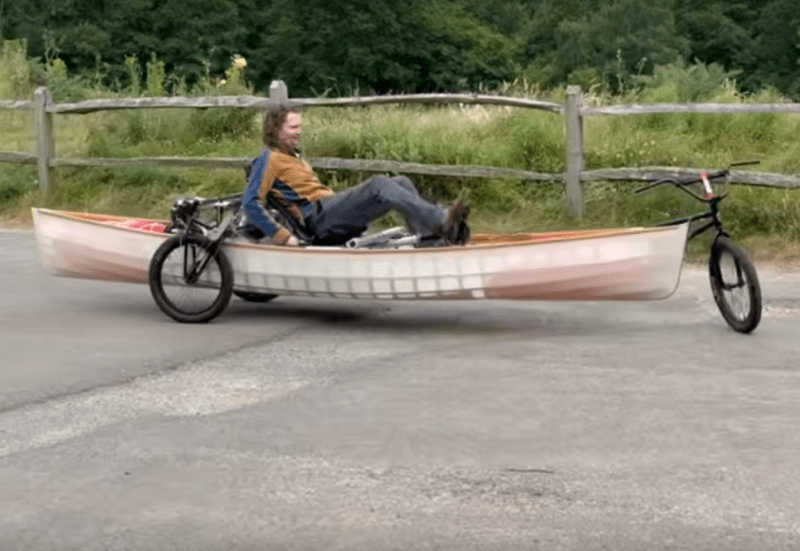Normally when making a long voyage in a canoe, an adventurer would paddle the vessel as far as possible and then “portage”, or carry, the canoe over the short sections of land separating the bodies of water. Portaging is a lot of work, though, since canoes generally aren’t particularly light or designed for traveling over land. To solve this problem, [Ben] is modifying his home-built canoe with some interesting parts to make it into an amphibious vehicle which can much more easily traverse land.
The wheels for the amphibious craft come from BMX bicycles, which have much smaller wheels as well as more robust frames when compared to more traditional bicycles. The rear of the canoe was modified to use a go-kart axle with two driven wheels. An additional set of cranks mounted outboard drive a custom-built paddle to propel the boat when traveling on water. The frame borrows heavily from recumbent bicycle design and includes a similarly comfortable seat, with steering handled by a wheel at the front when traveling on land and a rudder at the rear when traveling over water.
[Ben] intends to take this unique vehicle on a cross-country trip across Scotland, with the first part of the adventure on water via the Caledonian Canal and the return trip on land via the Great Glen Way. Hopefully, there’s no actual portaging required for his trip as the bike components add a tremendous amount of weight to the boat. [Ben] he even added a sail that could theoretically be used in either mode. We’ll be keeping watch for his next videos showing his adventure, and in the meantime daydreaming about other unique bikes that let you travel where bikes normally can’t.
Thanks to [Risu no Kairu] for the tip!
















What an incredible experience. He has hacked a canoe and a bicycle into a seaworthy craft. I say have at it! I will wait upon these sidelines. Gracefully watched your adventures in the Pacific Ocean.
I kayak frequently, and have done numerous canoe and kayak trips. (Maybe 20 trips this summer alone – I don’t keep count.) Sometimes my trips are week long or longer.
Portaging is usually done around obstacles, almost always dams. You paddle up to the string of buoys next to the dam, on one side there’s a sign of some kind showing you the portage, you go around to the lower side of the dam, and put in again.
The portage is almost never flat and paved. It’s usually a path up the bank at the top and down the bank at the bottom, it’s irregular and uneven. There’s no incentive to make it easy, paddlers want the portage as short as possible, and they want to put in as close to the dam as they can. (The put-in below the Moore dam is particularly impressive.)
I’ve bin on portages between lakes in the woods too, and these are also usually paths.
So while this is an interesting and well done project, it’s probably only useful for the specific area he’s in, if he already knows there’s a significant portage that’s flat and paved.
(I haven’t paddled in Scotland, that might be the case there.)
Actually canoes are pretty light, so saying that they’re not calls the whole article into question; the extra gear outweighs the canoe. As PWalsh suggests, there’s never a road around when you need one. Epicfailcoolstorybro.
Personally I prefer the Autocanoe, in which the bicycle wheels are also paddlewheels! Plans available for purchase here:
https://duckworks.com/autocanoe-plans-pdf/
Paddlewheels are horrible. They have an extremely low efficiency, and because of that they have been obsolete for over 150 years.
Cool project, but I prefer a regular kayak cart for my kayak, although I often have a folding bike strapped to the back in stainless mounts I’ve added. It is way faster to cycle back and fetch the car than walking, and I can strap the kayaks nose to the bike for longer road stretches.
Depending upon local laws, does he need to wear a bicycle helmet while canoeing, or a life jacket while bicycling?
Both at all times, or do they cancel themselves out?
B^)
Ha!
This is why I have a foldable bike and (quality) inflatable canoë. Now the only thing missing is holidays to plan a long trip.
I remember these from back in the 70s. They were for canoes and rowboats to help move them in flat, even ground (parking lots, driveways, storage areas, boat launch ramps) but were useless in portaging around the usual things like boulders and fallen trees.